Which one is the best ERP system: SAP or Oracle?
Category: SAP Posted:Jul 25, 2018 By: Robert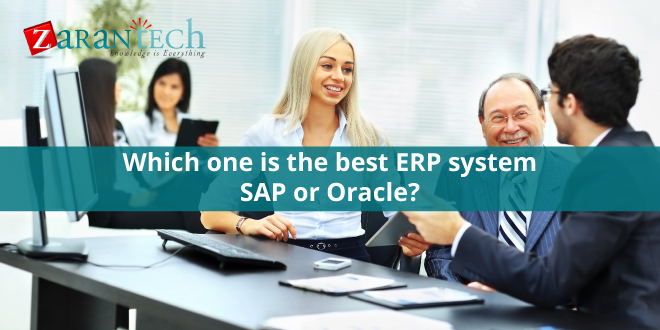 In the human body, the brain is the important part, which controls all other elements by instructing them what work they need to do and also ensure that they are working fine together. We know that the human body cannot function properly without a brain. Similarly, an enterprise fails to perform correctly without an appropriate ERP system. ERP i.e. Enterprise Resource Planning system acts as the brain of the Organization’s technology system. It combines all the aspects of a business, including product development, manufacturing, marketing, and sales. With the coordination of all these area’s businesses can acquire visibility, improve productivity and operational efficiency, decreases costs and increases competitiveness.
In the human body, the brain is the important part, which controls all other elements by instructing them what work they need to do and also ensure that they are working fine together. We know that the human body cannot function properly without a brain. Similarly, an enterprise fails to perform correctly without an appropriate ERP system. ERP i.e. Enterprise Resource Planning system acts as the brain of the Organization’s technology system. It combines all the aspects of a business, including product development, manufacturing, marketing, and sales. With the coordination of all these area’s businesses can acquire visibility, improve productivity and operational efficiency, decreases costs and increases competitiveness.
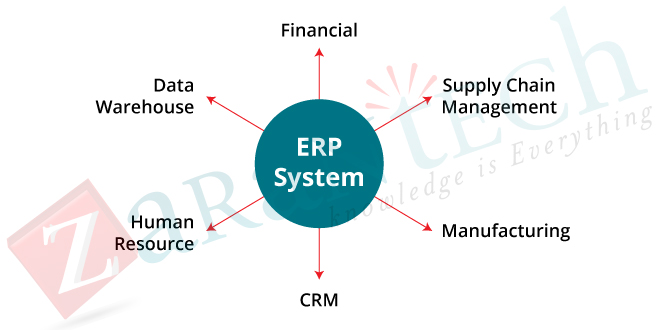
ERP is a business management software which permits a company to influence a suite of incorporating applications to restructure and automate various processes, developing a learner with more correct and effective operations. It provides comprehensive ability into the core business operations and improves systems with the help of an excellent resource tracking and reporting, database management and data sharing and overall improved information systems. It empowers the business growth. With the help of an ERP system, the businesses can expand without the addition of IT or recruitment costs.
An ERP system provides excessive benefits to your organization; however, it also can take time, effort and financial resources to implement and use it regularly. The complete ERP tools help businesses to cut through the uncertainty and drive better decision-making with the help of a flawless appearance and procedures. As ERP provides several benefits to the different organization, they are utilizing it, but sometime they may get confused that which ERP system they should use. This article presents a comparison between the Oracle and SAP: the two most commonly utilized ERP software package that helps the businesses to take the better decision for the selection of an ERP system.
Both SAP and Oracle are the clear market share leaders and have solid established product lines, strength, weaknesses, risks, and product roadmaps. These two vendors are similar in various aspects. A report by Panorama consulting shows the measurable results from hundreds of ERP implementation throughout the world. Based on this report it’s recognized that the SAP and Oracle customers have very dissimilar results in implementing and consuming these two products. There are various parameters to be considered which would be helpful in reducing the differences between the two products. The various key parameters are implementation risk, cost and duration, software functionality and customization, scalability, and adoption of the cloud platform. These parameters stress on some of the major differences between the two products and their future instructions.
Implementation Risk:
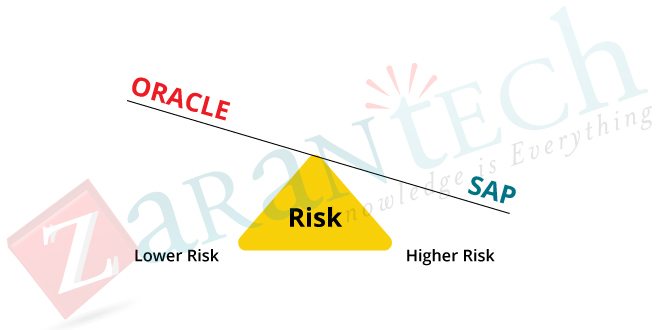
The management in every organization more concern about the risk of their implementation, that’s the reason they are continually looking for various techniques and tools which help them to simplify the failure risk. Data collected from a titan’s report ensures that these risks are really a concern. More SAP customers claim that their implementations were a failure than the Oracle’s one. When the application goes live it is noticed that more SAP customers have come across a particular type of substantial operational interference, for example, they may not be able to dispatch the product or close the books.
Research shows that, as compared to Oracle products, SAP has a high-risk implementation profile; every ERP customer may experience a higher degree of risk. Therefore, risk management techniques are developed by these two vendors to report the worries. For instance, SAP’s all-in-one product includes best practices and pre-arrangements for diverse industry verticals, with the plan for reducing risk and quickening usage. Oracle has developed a similar kind of tool concerning to the increasing speed with its line of implementation, quickening agents and its user productivity kit. Both are designed to perform testing, training, and other key implementation processes more proficiently and effectively.
Scalability:
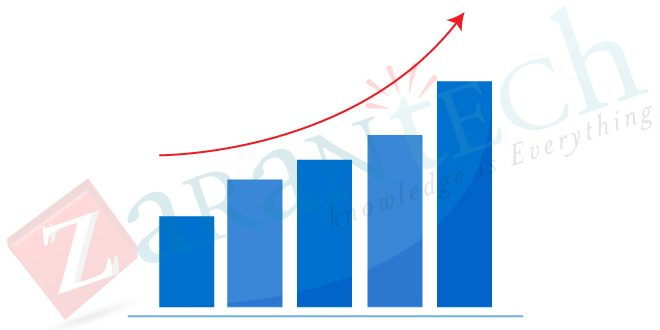
Scalability is another factor which of great concern for most of the mid-market and larger organizations for their ERP systems. The organizations are typically looking for their enterprise software to provide the adequate support which helps in the growth and scale of their companies, frequently after years of uneven and varying business processes and systems. In this area, the SAP and Oracle are equally even, for various reasons. The world’s most prominent organizations are now able to scale their companies with any of these products, this is because most Fortune 500 organizations are using either or both the products. But the scalability degree depends on the requirements of the particular organizations. With the help of various solutions of Oracle like E-Business Suite, Fusion, JD Edwards, Seibel, and Hyperion it has developed more of a best of bread possibility. SAP has mostly created its product from the ground level, generating a more consistent and feeling of a “single system”. The organizations which are observing for scalability through reliability and regularization find out SAP more scalable, whereas the organizations which are functioning from a more decentralized model based on flexibility may be appropriate for Oracle’s suite of products.
Software functionality and customization:
The technological support of selected ERP system does not matter. As an alternative, the buyers of the enterprise are investing money in the enhancements and functionality to their various business procedures. When both SAP and Oracle are compared on the basis of this parameter, it is clear that both vendors are dedicated for improving the functionality. The SAP customers usually recognize most of their predictable functionality and business benefits as compared to the Oracle’s customers. On the other side, the oracle’s customers recognize quicker returns than the SAP clients. There is always a fear of customization in every CIO’s mind. The simplicity of customization is a genuine requirement for the associations to confirm a solid match between their ERP framework and operational requirements. But on account of SAP and Oracle, the clients of both the vendors alter the software product a lot, which is not all by itself is an awful thing. As stated earlier, the best-of-breed arrangements of Oracle’s provide alternatives to extend groups not having any desire to modify their software product, on the other hand, the customization and integration tools are also provided by SAP to make its software more adaptable for its endeavors clients.
Cost and Duration of Implementation:
When it is required to consider as a percentage of annual enterprise budgets, SAP is the higher cost preference. On an average, the SAP customer’s spends around 4% of their yearly income on its total cost of ownership, whereas Oracle customers only pay 1.7%. Well, this is credited to the scope of functionality and therefore connecting the higher cost with the SAP’s software. It may be a sign of a large organization spoiling their implementations of the product. The cost is nothing but only an implementation equation part, the CIOs and project teams are also anxious about the duration of the implementation. The average Oracle customer takes 22.5 months to implement; the average SAP customer can perform this within four months or less time. Also, to lower the risk, the SAP’s Pre-configurations and Oracle’s accelerators will help to speed up the implementation timeframe.
In-memory Technology:
SAP and Oracle both have in-memory technology system, it has been observed from past years that these two vendors are claiming about their in-memory technology that how it’s going to modify the future of ERP. The SAP is advancing with the use of their in-memory database because SAP HANA is distinguishing itself as very much functional “all-in-memory” system. It would always be beneficial to have a single platform, but at the same time, it has its own drawbacks for example deployment cost and limitations in compatibility. SAP HANA is an excellent success of SAP.
Similarly, Oracle has also shown massive improvement with their new database in-memory system by distinguishing their system as actually efficient and easy to integrate with the comprehensive databases and applications. The Oracle database is beneficial concerning to cost, especially to those who are using the compatible databases. However, these systems may not be so convenient and do not provide the scope of a centralized system. If we keep the technical dissimilarities between these two systems sideways, it will give the same outcomes for the business and the customer. With the help of in-memory technology, it is possible for the customer to run the necessary ERP applications and analytics quicker, and finally, it delivers superior efficiency and awareness.
Cloud Adoption:
Previously, most of the organizations were hosting the big, robust ERP system and other enterprise software applications. In its place, an increasing number of organizations are transferring their products towards the clouds, no matter if it would be through pure software as a service, through traditional, or single instance settings introduced by a third-party provider. When the SAP and the Oracle are compared with respect to the cloud platform, the Oracle is observed a little bit at higher levels than SAP, because most of the Oracle customers are leveraging cloud options and also they experienced quantifiable business benefits with this option. SAP’s Business one, considered this as the most feasible cloud-based contribution to the small size businesses. Although, both the vendors adopted the cloud delivery models, Oracle is the most successful vendor in this area as compared to SAP.
Conclusion:
The points discussed in this article may not conclude that either of the vendors has a clear and significant advantage over the other, but it proposes some areas that are evaluated by most of the ERP customers. Every organization has different urgencies and assessment standards, however, these products can be compared on the basis of different areas. Both SAP and Oracle’s ERP tools are expanded broadly to modify a platform, according to the company’s requirements. Both of them deliver comprehensive support for all those company lifecycles that happens around the products, services, assets, and suppliers. They also provide the facility to the customer to select from a wide-ranging list of options given for the solutions that suit them. Thus, by utilizing the benefits of these solution suites requires devoted to research and a lot of forward and backward about what an organization does, and what it has entirely done as far as center investigation and business insight use.
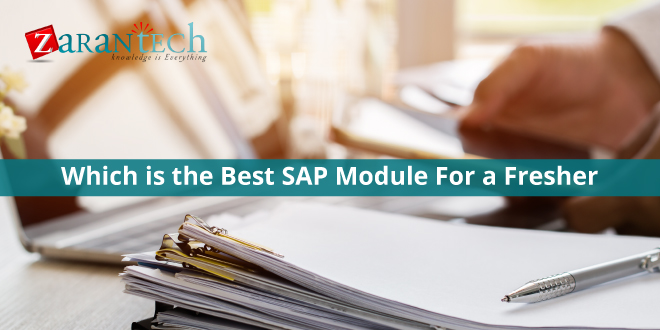

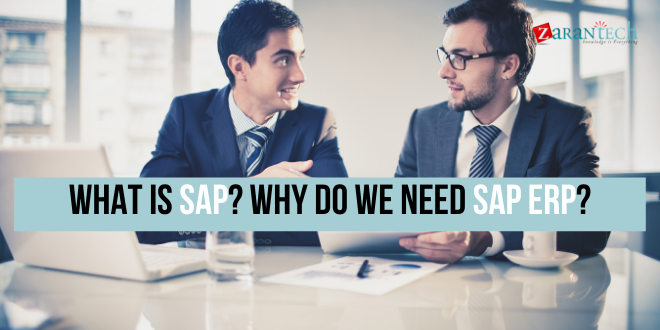
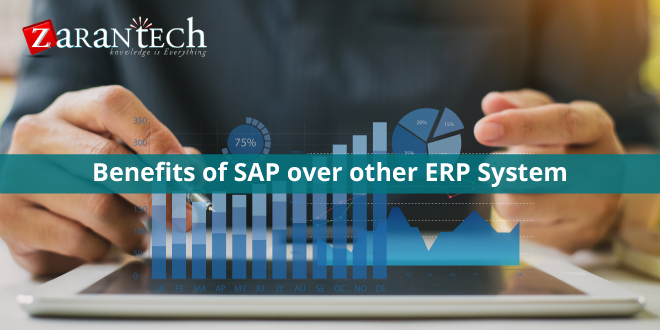

 99999999 (Toll Free)
99999999 (Toll Free)  +91 9999999
+91 9999999